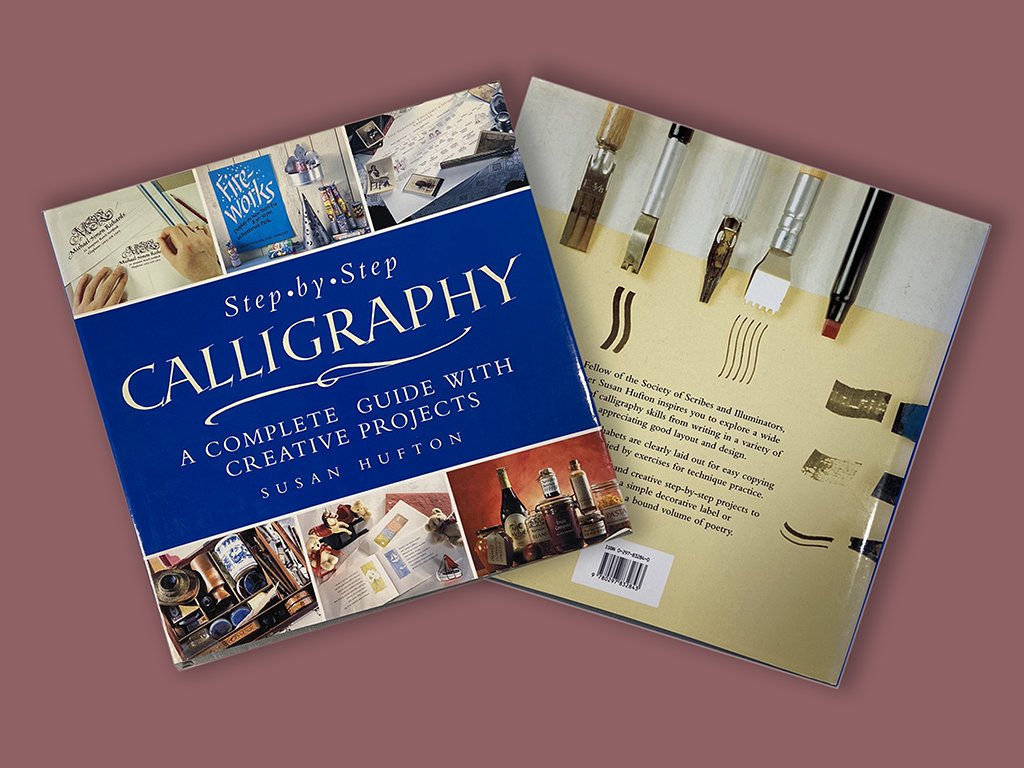My recommended top 5 calligraphy books for beginners.
Despite the abundance of information on the internet, books are still the best resource to kick-start your calligraphy practice. When I began learning calligraphy (many, many moons ago), I bought every book on the subject under the sun – and I still use many of them to inform my studies, practice and teaching.
Here are my five recommendations for calligraphy books suitable for beginners who wish to learn more about the traditional craft of calligraphy. I’m not advocating that you purchase all five of these, because each one offers sound, clear guidance about calligraphy tools, how to write the letterforms correctly, and has step-by-step projects for you to show off your newly acquired skills.
There is one drawback to this list: some of the books are out of print! But, keep your eyes peeled because you may come across second-hand copies in your local charity or second-hand shop, or on Amazon or eBay.
1) The Practical Guide to Calligraphy Rosemary Sassoon
ISBN 0 500 27251 4 Published 1982
If you’re looking for a book covering hundreds of different calligraphy styles, with instructions on how to write each letterform, well, then I’m afraid this book isn’t for you. Instead, the author gives an overview of her working life as a commercial lettering artist, by showing examples of real commissions rather than perfect exemplars. This was the first calligraphy book I bought, and it inspired me to try different calligraphy tools and to make things, even though my writing wasn’t perfect. She also suggests looking at letterforms that are all around us, whether written, carved or printed – because they influence our lives on every level. This book is ideal for the beginner who wants to get started without getting bogged down in detail.
2) Step By Step Calligraphy Susan Hufton
ISBN 0 297 83284 0 Published 1995
This book is at the other end of the spectrum and is targeted at the serious learner, whether you’re a beginner or someone with more experience. Sue Hufton is a highly regarded calligrapher and teacher, and in this book she explains the complexity of learning calligraphy in a way that is easily understood. Rather than presenting a myriad of different scripts, she focuses on five major calligraphic hands, beginning with Roman Imperial capitals. These are stripped back to skeleton letters and then they are built up to pen capitals, written with a broad-edge pen. The other scripts are: Foundational, Italic, Uncials and Versals, along with fifteen step-by-step practical projects showing you how to effectively integrate them into a piece of work. There’s loads of information inside this book, not only for the beginner but even for those with more experience.
3) Foundations of Calligraphy Sheila Waters
ISBN 0 9665305 1 9 Published 2006
This book began as a series of articles that appeared in the Letter Arts Review between 1995 and 2000, and it’s a comprehensive guide to learning how to write and modernise historical scripts. At the start of each different script, Sheila Waters provides historical information and examples of writing from each period, and some contemporary variations. She shows examples of bad letterforms in addition to the good ones, which is very beneficial to those who don’t have access to a teacher. She shows you how to vary the hand to create the sort of mood you are looking for, and gives advice on how to practise for optimal results. There are no set projects, but there are many examples of Sheila’s glorious work.
4) Calligraphy Step by Step Gaynor Goffe
ISBN 0 00 412803 6 Published 1994
Like many left-handers, I struggled when it came to learning how to write with a broad-edged pen. But, when I bought this book and discovered that Gaynor Goffe is also left-handed, I knew that it would be possible for me to acquire this skill. This book isn’t just for left-handers, though; it’s a good starting point for anyone interested in broad-edged-pen calligraphy, as it takes you through from setting up to completing projects. There are easy-to-follow instructions for ten different calligraphy scripts, including my favourite: cursive italic. And shown alongside are examples of work by leading calligraphers. So, if you’re someone who enjoys writing many different scripts – this is the book for you.
5) Calligraphy Margaret Daubney
ISBN 1 86126 230 2 Published 2000
I had the privilege of being taught and mentored by Margaret Daubney while I was studying for my calligraphy and bookbinding degree at Roehampton. Margaret was a wonderful teacher; very pragmatic and down to earth, and she showed me that alphabets are not 26 separate elements, but groups of related shapes and patterns (which is obvious when you think about it). This book takes a slightly different approach than those aimed at the beginner, in that it begins with the usual instructions on how to write the five basic calligraphic scripts: Roman Capitals, Foundational, Italics and Uncials, based on historical models. But then she takes the reader ‘beyond the rules’ by showing how these letterforms can be adapted by changing the weight or the angle of the nib. This book doesn’t contain any projects, but if you enjoy interpreting words and experimenting with letter shapes, there are plenty of ideas for you to explore so you can make your own discoveries.





